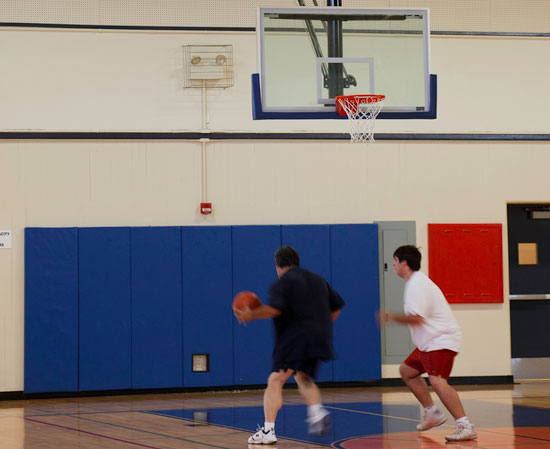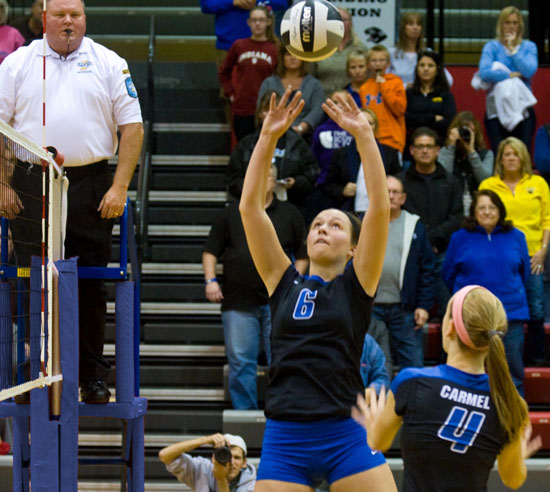Safety in the Gym: Specifying Equipment to Protect Users and Spectators
Practice/Batting Cage Safety Guidelines
The need for safe and appropriately spaced practice and batting cage protection is clear. Without enough space between them, a cage’s netting does not have room to reach its full stretch and stop the progress of a ball coming in contact with a solid surface. This is a dangerous prospect that may result in various injuries.
Cages should be at least 24 inches away from any solid surface.
To stop a baseball or softball, netting can have openings as large as 1½ inches, but golf balls will go through 1½-inch netting. To stop golf balls, the netting openings should be ¾ of an inch. This ensures the safety of people outside multi-sport practice cages.
Corners on each end of one long side should be zippered, tied, or have hook-and-loop so it can be separated from other sides. This side can fold up on top of the frame, and multiple users could hit golf balls into the other long side—it increases the usefulness of the cage by allowing safe use by multiple people.
Batting Cage Winches and Safety Locks
A UL listing is not available for batting cage winches, which are normally identical to divider curtain winches. For batting cages, winches need either a self-locking gear ratio of 60-to-one or higher, or a brake mechanism. As with gym dividers, audible alarms provide a warning to gym users when the cage winch is in operation. These alarms provide a pulsating 80-decibel sound when the cage winch is energized.
Use of curtain locks on practice/batting cages stops the rotation of the drive shaft if the speed of the rotation exceeds the preset trip point. Curtain locks for practice cages have a definite rotation direction and only work in one direction.
It is probably more important to use a curtain lock on a practice cage than on a divider curtain because practice cages have a larger footprint, normally at least 10 feet wide and at least 55 feet long (usually 70 feet to 75 feet long), so they cover a large area on the floor. If a cage falls, there is a greater chance of someone being in the area where the cage will hit.
Safety straps can also be used on practice cages. At least three are required. In addition to locating one at each of two opposing corners, one should be placed in the center. Having only two creates a false sense of safety. The frame tube is too flexible for the entire length to be supported only from the ends; the middle of the cage will still hit the floor without a safety strap also being located in the center.
Proper Operation and Placement of Equipment Controls
Improper use of heavy gym equipment could lead to equipment damage or injury to bystanders. Only properly trained and authorized personnel should be allowed to operate gymnasium equipment.
The operator needs to make sure that areas below and around equipment being operated are clear of people and sports equipment. If necessary, have a “spotter” to help keep an eye on the area.
To secure controls and to prevent unauthorized users from operating equipment, the following safeguards should be in place. The controls:
- Should require a key or password, or be able to be carried by an authorized user (i.e. wireless remotes).
- Must be momentary contact, which means the user has to keep the switch in “on” position or hold a finger on the button. When the key or button is released, the equipment immediately stops.
Backboard controls should never be located below a backstop; they should be 4 to 6 feet outside of the widest point of the backstop.
For maximum protection of bystanders, divider curtain controls should be at one end of the curtain—but only if the curtain edge is at least 3 feet from the wall—so the operator can see both sides of the curtain. If this is not possible from the key location, then two people are needed to operate a curtain—one at the key switch and someone else on the other side who can notify the key operator in case the curtain needs to be stopped.
GYM WALL PADDING: CONSEQUENCES
Examples of the need for gym wall padding—to ensure safety—are numerous.
In 1997, for instance, an eighth-grade student tripped while practicing basketball and ran headfirst into a gym wall, resulting in a serious neck injury. In this case, the wall was 5 feet from the boundary of the basketball court, and it was covered with a mat (of an unknown condition that was reportedly later replaced).
When paramedics arrived at the boy’s middle school in Ohio, the boy was not breathing and had no pulse. The boy was never able to breathe on his own again, and, when life support was later removed, he died.

Photo courtesy of Draper, Inc.
Wall padding can make the differnce between a minor accident and a tragedy. Wall padding can be specified that does not emit harmful VOCs.
Any hard surface that participants might come in contact with during play or practice should be adequately padded to prevent serious injury.
The National Federation of State High School Association rule book reads: “There shall be at least 3 feet (and preferably 10 feet) of unobstructed space outside boundary lines.”
The National Collegiate Athletic Association and other sanctioning body rulebooks have requirements and suggestions in almost the same wording.
The intent of the buffer zone is to allow athletes space to slow down before reaching the walls or other obstacles outside the area of play.
Based on the case illustrated above, 3 feet is definitely not enough, and even at 10 feet, adequate padding is needed to prevent serious injury.
A further complication comes in the form of cross-court configurations. To maximize the safety of athletes, collegiate and professional facilities are padding all hard surfaces regardless of how close they are to the court.
The tendency may be to focus all safety concerns and financial outlays for collegiate and professional players. After all, these elite athletes often bring fame and fortune to the institutions with which they are aligned, and may earn hefty compensation for themselves, their managers, and their professional team.
However, all athletes deserve the same level of protection. In fact, younger players might reasonably be expected to have less control, and be more likely to fall or fail to stop in time.
MEASUREMENTS FOR SAFETY: GMAX AND HIC
Gmax measures the shock attenuation performance of sports surfaces. Gmax is the measure of the maximum acceleration (shock) produced by an impact. Head Injury Criterion (often referred to as HIC) measures the likelihood of head injury arising from an impact.
For both Gmax and HIC, the most important thing to remember is that the lower the measures are, the better and the safer.
ASTM F2440-11 Standard Specification for Indoor Wall/Feature Padding indicates the minimum acceptable level for shock absorption:
- Gmax: less than 200
- HIC: less than 1,000
For the life, health, and safety of gymnasium users and athletes, and to protect all parties from liability and lawsuits, do not use any wall pad that does not meet ASTM F2440-11.
FIRE SAFETY
When considering safety, it’s important not to forget fire safety. Although not required in most areas, Class A-rated wall pads are almost always required in New York, Rhode Island, Connecticut, and Tennessee.
However, in other areas, a Class A rating for wall pads may not be necessary if pads are mounted to concrete masonry unit (CMU) walls (concrete blocks, pre-fabricated concrete walls, poured-in-place concrete walls, etc.).
Wall pads must be tested as a complete unit, and not just contain Class A vinyl and/or Class A foam. Even when combined, these materials may not meet the standard.
The standards for gymnasium wall pads are:
- NFPA (National Fire Protection Association) 101 - Class A Rated
- Testing Method is ASTM E-84/NFPA 255
- Flame Spread ≤ 25
- Smoke Development ≤ 450
- NFPA 286 - Standard Method of Fire Tests for Evaluating Contribution of Wall and Ceiling Interior Finish to Room Fire Growth
According to NFPA, “Measurements in the fire test room document extent of fire growth, rate of heat release, total heat released, time to flashover, time to flame extension, total heat flux incident to the floor, upper level gas temperature, smoke obscuration, production of carbon monoxide, and emissions of other combustion gases.”

Photo courtesy of Draper, Inc.
Padded poles and judges stands helps protect players.
Volleyball Equipment
For the safe and proper design of volleyball courts, posts need to be 36 inches outside court lines. This is required by rules for player safety.
A further way to promote player safety is to never use volleyball posts or judges stands without proper padding. Such pads need to be at least 66 inches tall.
Plus, all surfaces facing toward the court need to be padded. It is acceptable for surfaces facing away from the court to remain unpadded.
Wrestling Mat Lifters
In the vast majority of gymnasiums, especially school and college gyms, many sports and competitions need to happen at different times. Thus, certain equipment needs to be moved out of the way. Wrestling mats can be as large as 45 feet by 45 feet, and weigh one pound per square foot. Obviously, rolling up and moving such a large piece of equipment needs the help of machinery.
Ideally, gyms can store wrestling mats up off the floor with the help of a mat lifter. These may be made for single mats, double mats, or sectional mats. Storing wrestling mats in this type of equipment prevents injuries that are possible when moving them. Mats stored in mat lifters are also secure from damage or possible liability for injuries caused by people climbing on or around them.
Mats are lowered and lifted with a key switch control. Continuous straps wrap completely around the mat to stop it from falling should the sling become torn. For safety purposes, the sling capacity governs the lift capacity of the system.
While mats are heavy, the mat lifter itself could weigh about a ton, so it has to be properly designed, manufactured, and installed.









